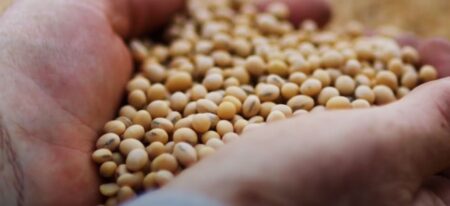The European Union (EU) said it’s ready to strike back with tariffs if President Donald Trump follows through on threatened August tariffs affecting EU exports to the U.S. Speaking of trade, Trump nominated Julie Callahan to be U.S. Trade Representative’s (USTR) chief ag negotiator.
The president also made news about Coca-Cola, saying the iconic global soft drink will start using cane sugar in its U.S. product instead of corn syrup. But Coke has yet to confirm. Long-term conservation funding got a boost in the reconciliation bill just signed into law, but that boost could come with short-term costs. And the USDA came out with plan to ensure farm security in the U.S., but some experts say personnel shortages could be an issue.
Key Takeaways
- The EU is prepared to impose over $7 billion in retaliatory tariffs on U.S. agricultural exports if new U.S. tariffs take effect August 1.
- USDA’s new farm security plan aims to counter foreign threats, but experts warn it’s under-resourced to be effective.
- A budget shift will boost conservation funding long-term, but farmers could see less support in the near future.
1. EU Tariff Retaliation Would Hit More Than $7 Billion in Ag Exports
A second wave of EU retaliatory tariffs would hit more than $7 billion in annual ag exports from the U.S. That’s according to a copy of a list obtained by Agri-Pulse. The EU tariffs would happen if negotiations with the U.S. fall through and if President Trump goes ahead with Aug. 1 tariffs on EU exports.
EU policymakers approved retaliatory tariffs on an earlier list of products worth more than $25 billion in March. Agricultural products taking the hit would include grains, meats, and vegetables. Those countermeasures were set to happen earlier this week but were put on hold until Aug. 1 to let talks play out.
A second list in the works would slap tariffs on a further $84 billion worth of U.S. products, including around $7.4 billion on agri-food exports.
Fruit and vegetables make up the largest share of targeted ag products, weighing in at more than $2 billion in annual exports. Wine, beer, and other alcoholic beverages account for another $1.4 billion, while fish and seafood, animal products, and tobacco make up around $600 million, $340 million, and $130 million, respectively. The list is wide-ranging, hitting a variety of U.S. meat exports, nuts, dried and fresh fruits and vegetables, seafood, mushrooms, and bourbon.
Aside from U.S. agricultural products, the list includes a slate of U.S. industrial products, including Boeing planes, cars, medical devices, and chemicals.
2. Experts Say New USDA Farm Security Plan Needs More Resources
USDA’s new farm security plan should help strengthen federal efforts to track foreign influence over U.S. agriculture. But experts tell Agri-Pulse that there might not be enough USDA personnel to make the plan work.
“It does set a marker to put [federal] agencies on record to make sure they prioritize programs that address real national security issues like bioterrorism” and other nations’ efforts “to do things to harm our agricultural industries here domestically,” said Nova Daly, a senior public adviser at Wiley, a major Washington, D.C., law firm. “Make no mistake about it, China is looking for vulnerabilities in the U.S., including in the ag sector.
“It’s framed in a way that’s not a traditional document to see for policy purposes,” Daly said, but “it puts them on the hook for a number of things,” he added.
Daly pointed to a July 8 memorandum with the Treasury Department that outlines implementation of language in the fiscal 2024 appropriations bill requiring USDA to take part in proceedings of the Committee on Foreign Investment in the United States (CFIUS) on a case-by-case basis.
Daly’s an expert on CFIUS who has held senior leadership posts at the departments of the Treasury and Commerce, in the White House, and in the Senate. He testified before Congress on the issue last year.
But he and Kevin Shea, former administrator of USDA’s Animal and Plant Health Inspection Service, both said more staff are needed to implement the measures. Shea said cuts at USDA Animal and Plant Health Inspection Service could present a challenge to implement the plan.
3. Callahan Nominated for USTR Chief Ag Negotiator
President Trump has chosen Julie Callahan, a nine-year veteran of the Office of the U.S. Trade Representative, to be USTR’s chief agricultural negotiator.
Callahan has been at the agency since 2016, holding multiple positions in the Agricultural Affairs office. She has been the assistant USTR for agricultural affairs and commodity policy since April 2020, according to her LinkedIn profile.
The nomination went to the Senate Finance Committee on Wednesday, according to congress.gov, with the White House announcing the nomination on Thursday morning.
Agricultural industry groups wanted the administration to swiftly fill the position. A July 8 letter to the president from more than 40 trade associations called for Trump to “expeditiously” nominate a candidate for the position to ensure agricultural issues receive priority in ongoing trade negotiations.
If confirmed, Callahan would join the administration as it seeks to cut deals with more than a dozen of the U.S.’ largest trading partners and looks for new markets for U.S. agriculture.
4. Will Coca-Cola Switch to Cane Sugar?
President Trump said Wednesday that Coca-Cola will start using can sugar in its U.S. products instead of high-fructose corn syrup, but Coca-Cola has yet to confirm the change.
Trump said, “I have been speaking to Coca-Cola about using real Cane Sugar in Coke in the United States, and they have agreed to do so.” Trump added, “I’d like to thank all of those in authority at Coca-Cola. This will be a very good move by them — You’ll see. It’s just better!”
But Coca-Cola said in a statement that it was non-committal about the switch. “We appreciate President Trump’s enthusiasm for our iconic Coca-Cola brand,” the company wrote. “More details on new innovative offerings within our Coca-Cola product range will be shared soon.”
Coke is sweetened with high-fructose corn syrup in the U.S., but in other countries including Mexico, it contains cane sugar.
Meanwhile, Corn Refiners Association President and CEO John Bode cautioned against the move in his own statement.
“Replacing high-fructose corn syrup with cane sugar doesn’t make sense. President Trump stands for American manufacturing jobs, American farmers, and reducing the trade deficit,” Bode said. “Replacing high-fructose corn syrup with cane sugar would cost thousands of American food manufacturing jobs, depress farm income, and boost imports of foreign sugar, all with no nutritional benefit.”
5. Reconciliation Boosts Long-Term Conservation Funding but at Near-Term Cost
Conservation programs will get a long-term funding hike under the budget reconciliation bill recently signed into law. However, that boost comes with short-term cost. For the coming fiscal year, there will be significantly less money for program applicants than there would have been otherwise.
Unobligated Inflation Reduction Act (IRA) funding previously expected in fiscal 2025 and 2026 for the Agricultural Conservation Easement Program, the Regional Conservation Partnership Program, the Environmental Quality Incentives Program, and the Conservation Stewardship Program has been rescinded to be folded into the permanent farm bill baseline.
Because of congressional budget rules, that change should guarantee somewhat higher funding levels for these programs over the coming decade and beyond. But this will likely mean that fewer producers will get funding for their projects in FY26 compared to what they could have gotten under IRA — at least for some programs. That’s according to National Sustainable Agriculture Coalition policy specialist Jesse Womack.
“I think, ultimately, the trade-off we just made is we’re going to see slightly smaller single-year signups in FY26 than we saw in FY24,” Womack said. “But we’re going to see that level increase a little bit over the next couple years and then be maintained in perpetuity.”
Agri-Pulse is a trusted source in Washington, D.C., with the largest editorial team focused on food and farm policy coverage.


:max_bytes(150000):strip_icc()/SoybeanRedCrownRotSPorter-a25a83ece6b54909b3e6ba0d997bd49c.jpg)




:max_bytes(150000):strip_icc()/GettyImages-2225249193-07f6ac3f0b6748c7931cab461f729e87.jpg)

:max_bytes(150000):strip_icc()/Cotton-Harvest-Matt-Miles-88f0df3cb0b84cc2aacfe15e4c15bda8.jpeg)
:max_bytes(150000):strip_icc()/IMG_7936-c12c642ad0064146a4aecfc1a60502a3.jpeg)
:max_bytes(150000):strip_icc()/HTTJohnDeeretractorwithtillage_preview-6e8cfa3643f043efb29085bd78d76c98.jpg)
:max_bytes(150000):strip_icc()/Canadian20flag48553671412_aeb0538794_c-0bfa123de2b54e30ab4fadecae382d4a.jpg)